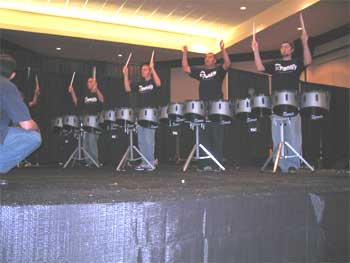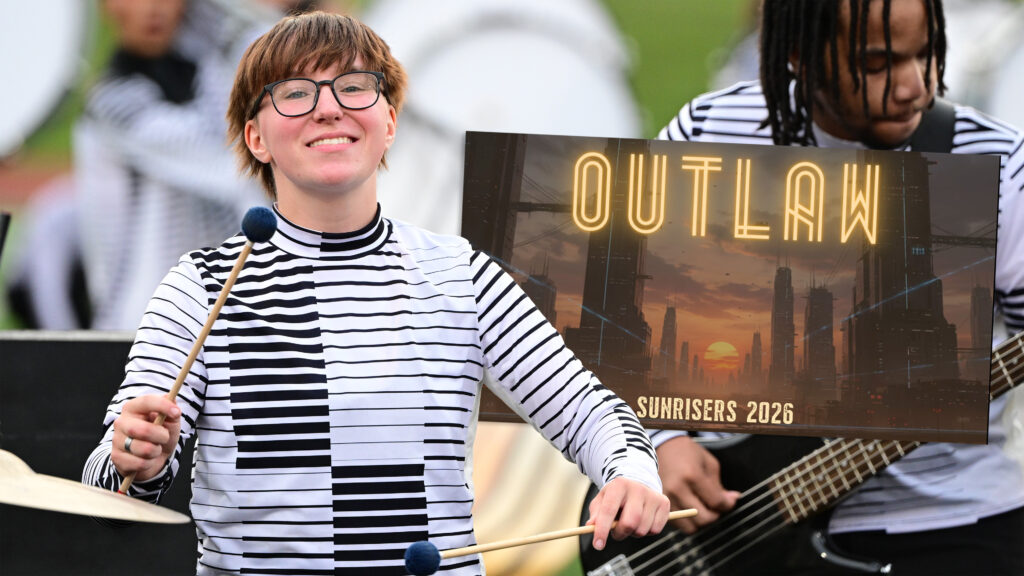On Saturday, Nov. 13, the eight snares, four tenors and five bass drums of the 2004 Blue Devils drum line battery presented a clinic at the most prestigious percussion event in the world, the Percussive Arts Society International Convention, held this year in Nashville, Tenn.
Video taken by Al Murray In front of a beyond-capacity crowd of screaming drummers and ecstatic percussion instructors, the line, led by instructor/arranger Scott Johnson, demonstrated how they warm up and why they warm up, performing a multitude of the special warmups that attract throngs of drum corps fans to the line in parking lots and practice fields every summer. The audience was clearly a significant

The clinic was titled, “The Blue Devils Drum and Bugle Percussion and the Who, What, How And Why: How They Do What They Do!” The line was brought to Nashville courtesy of Dynasty USA.
Scott Johnson told the audience, “We practice thousands of hours for a ten-minute show, so we’ve got to have fun. We have to warm up the brains as well as the hands, so the warmups are varied. We also change exercises as the music progresses during the season to address problems in the show.” Check out a Blue Devils at PASIC photo gallery.
You might not think that simple warmup exercises would have such a large audience on the verge of being thrilled beyond belief, but you would be wrong. The attendees hung on to every double beat exercise (constructed to warm up diddles) and every concentration exercise designed to warm up the brain. Scott had the audience repeat clapping patterns to show they were really paying attention to the rhythmic figures. Being able to trick vast numbers of the audience every time with simple alterations in counting showed those in the ballroom that concentration requires a continuous effort.
Exercises for flam accent heights and getting the feet to work together led into roll exercises based mostly on triplets (three strikes to the beat), with Scott explaining that the old exercises based on 16th notes (four strikes to the beat) were no longer viable due to tempos in field music being so much faster than they used to be. These increased tempos have made the old 16th note exercises impossible to play at the faster tempos, according to Scott.
Parts of the 2004 Blue Devils show were featured, such as how the line created the effect of a train leaving the station. Scott explained that each year, he seeks input from the members on licks to be put in the show. This input resulted in one of the more memorable segments of the drum book this past summer.
During a Q&A session, Scott surprised some by stating, “Feet are more important than hands. If they can’t march, they’re no good on the field and won’t stay in phase.”
Another fan asked how to practice to become a member of the line, resulting in a short discourse on how drumming uses different muscles and how one needs to address all of them in their warmups and exercises.
Allan Murray, vice president of Dynasty USA, was asked prior to the clinic why Dynasty made the investment to fly in all the members of the line for the clinic. He said, “People at this convention typically don’t have the opportunity to see drum lines from the West Coast, as PASIC is usually held in the Midwest or the East. It’s a big opportunity for percussionists who don’t personally experience the marching idiom. Dynasty is only five years old and in that time, we’ve developed all marching and concert drums, keyboards and timpani, giving us a legitimate role in the marching activity. It’s important for us to give something back to the kids, and this is one way to do it.”
Scott Johnson summed up his feelings about the success of the clinic and the thrill of performing a clinic for so many appreciative percussionists. “It was an honor for Blue Devils to play at PASIC. Yes, it was a challenge to get all the group together after three months, but they came through with flying colors.”
The folks who gave the line a standing ovation of close to five minutes would surely agree about the success of the event.





